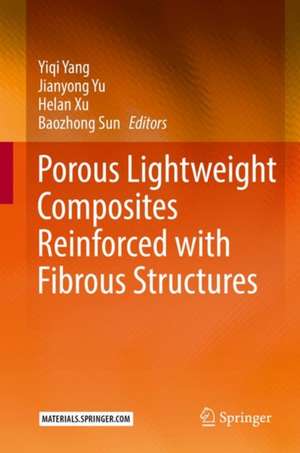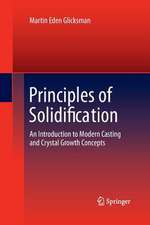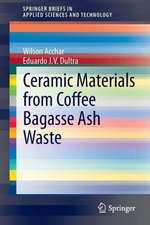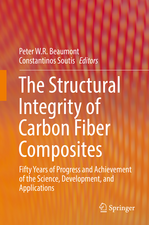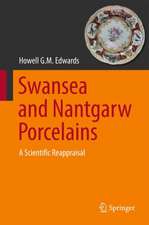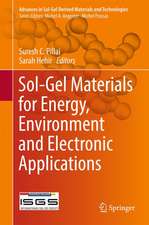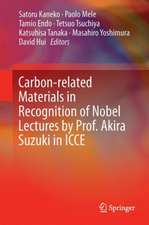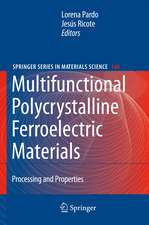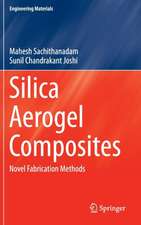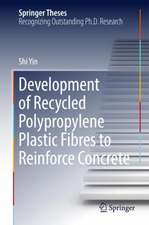Porous lightweight composites reinforced with fibrous structures
Editat de Yiqi Yang, Jianyong Yu, Helan Xu, Baozhong Sunen Limba Engleză Hardback – 13 aug 2017
Toate formatele și edițiile
| Toate formatele și edițiile | Preț | Express |
|---|---|---|
| Paperback (1) | 1042.68 lei 38-44 zile | |
| Springer Berlin, Heidelberg – 13 aug 2018 | 1042.68 lei 38-44 zile | |
| Hardback (1) | 1057.17 lei 38-44 zile | |
| Springer Berlin, Heidelberg – 13 aug 2017 | 1057.17 lei 38-44 zile |
Preț: 1057.17 lei
Preț vechi: 1391.02 lei
-24% Nou
Puncte Express: 1586
Preț estimativ în valută:
202.35€ • 219.87$ • 170.09£
202.35€ • 219.87$ • 170.09£
Carte tipărită la comandă
Livrare economică 15-21 aprilie
Preluare comenzi: 021 569.72.76
Specificații
ISBN-13: 9783662538029
ISBN-10: 3662538024
Pagini: 372
Ilustrații: XI, 368 p. 140 illus., 54 illus. in color.
Dimensiuni: 155 x 235 x 22 mm
Greutate: 0.77 kg
Ediția:1st ed. 2017
Editura: Springer Berlin, Heidelberg
Colecția Springer
Locul publicării:Berlin, Heidelberg, Germany
ISBN-10: 3662538024
Pagini: 372
Ilustrații: XI, 368 p. 140 illus., 54 illus. in color.
Dimensiuni: 155 x 235 x 22 mm
Greutate: 0.77 kg
Ediția:1st ed. 2017
Editura: Springer Berlin, Heidelberg
Colecția Springer
Locul publicării:Berlin, Heidelberg, Germany
Cuprins
High Performance Composites Produced from Dry-Processable Multi-Walled Carbon Nanotubes.- Composites Reinforced with Hollow Natural Organic Fibrous Structures.- Hollow/Porous Three-Dimensional Woven Structure Reinforced Composites.- Virtual Testing of Three-Dimensional Hollow/Porous Braided Composites.- Hollow Three-Dimensional Knitted Structure Reinforced Composites.- Advanced Grid Structures Reinforced Composites.- Porous Structures From Fibrous Proteins for Biomedical Applications.- Porous Structures from Biobased Synthetic Polymers via Freeze-Drying.- Porous Structures from Bio-Based Polymers via Supercritical Drying.- Carbon Nanotube-Based Aerogels as Preformed Porous Fibrous Network for Reinforcing Lightweight Composites.- Porous Lightweight Composites Reinforced with Natural and Agricultural Byproduct-Based Fibrous Structures.- Biobased Composites for Medical and Industrial Applications.- High-Performance Composites and Their Applications
Notă biografică
Dr. Yiqi Yang is a distinguished professor in the Department of Textiles, Merchandising and Fashion Design, University of Nebraska-Lincoln, Lincoln, Nebraska, United States. Dr. Yang received his PhD in Textile Science from Purdue University. He has extensive research experience in development of green materials including polymers and chemicals obtained from natural resources for textile, composite, and medical applications. He also has wide connection with textile industries across the world. He organized a symposium, “Light-Weight Materials from Biopolymers” for Division of Cellulose and Renewable Materials, in 246th American Chemical Society National Meeting (Indianapolis, IN, United States) in 2013. Based on the symposium, he edited a symposium series book composed of cutting-edge chapters related to lightweight materials contributed by experts from both academia and industries.
Dr. Jianyong Yu is an academician of Chinese Academy of Engineering. He obtained his PhD degree from Donghua University. He is currently a professor in Donghua University, and services as vice director of China Textile Engineering Society. He has been constantly striving to research and teaching in the area of textile materials, with focus on exploring basic theories, developing key technologies, and investigating industrial applications of innovative natural fibers, synthetic fibers, yarns, and functional textiles. Based on his contribution to the Chinese textile industry and academia, he received two second prizes of National Award for Technological Innovation and two second prizes of National Award for Progress in Science and Technology.
Dr. Helan Xu is a research assistant professor in the Department of Textiles, Merchandising and Fashion Design, University of Nebraska-Lincoln, Lincoln, Nebraska, United States. She received her PhD in Textile Sciences from University of Nebraska-Lincoln. Her research interests lie in developing industrial and biomedical products from agricultural byproducts and wastes. She has published papers on developing different lightweight materials, such as green composites, three-dimensional ultrafine fibrous scaffolds, hollow nanoparticles from chicken feathers, corn distillers grain, soy meal and other animal and plant originated residues for biomedical, textile and other industrial applications. She has also co-edited a symposium series book with Dr. Yiqi Yang published by American Chemical Society in 2015.
Dr. Baozhong Sun is a professor of Donghua University, Shanghai, China. He obtained his PhD degree in the specification of textile reinforced composites at Donghua University, joined College of Textiles of Donghua University in 2006, and became a full professor in 2012. He currently teaches courses of machine design, mechanics of materials and fracture mechanics in textile composites. His research interest is primarily focused on impact behavior, failure, and fracture of textile composite materials and textiles. He has participated in a number of key national projects and has served in organizing committees of a number of international conferences. He has authored and coauthored more than 120 papers regarding textile composite materials published in international journals and conference proceedings, and coauthored a book, “Impact Dynamics of the Textile Structural Composite Materials”, published by Science Press, Beijing, China.
Dr. Jianyong Yu is an academician of Chinese Academy of Engineering. He obtained his PhD degree from Donghua University. He is currently a professor in Donghua University, and services as vice director of China Textile Engineering Society. He has been constantly striving to research and teaching in the area of textile materials, with focus on exploring basic theories, developing key technologies, and investigating industrial applications of innovative natural fibers, synthetic fibers, yarns, and functional textiles. Based on his contribution to the Chinese textile industry and academia, he received two second prizes of National Award for Technological Innovation and two second prizes of National Award for Progress in Science and Technology.
Dr. Helan Xu is a research assistant professor in the Department of Textiles, Merchandising and Fashion Design, University of Nebraska-Lincoln, Lincoln, Nebraska, United States. She received her PhD in Textile Sciences from University of Nebraska-Lincoln. Her research interests lie in developing industrial and biomedical products from agricultural byproducts and wastes. She has published papers on developing different lightweight materials, such as green composites, three-dimensional ultrafine fibrous scaffolds, hollow nanoparticles from chicken feathers, corn distillers grain, soy meal and other animal and plant originated residues for biomedical, textile and other industrial applications. She has also co-edited a symposium series book with Dr. Yiqi Yang published by American Chemical Society in 2015.
Dr. Baozhong Sun is a professor of Donghua University, Shanghai, China. He obtained his PhD degree in the specification of textile reinforced composites at Donghua University, joined College of Textiles of Donghua University in 2006, and became a full professor in 2012. He currently teaches courses of machine design, mechanics of materials and fracture mechanics in textile composites. His research interest is primarily focused on impact behavior, failure, and fracture of textile composite materials and textiles. He has participated in a number of key national projects and has served in organizing committees of a number of international conferences. He has authored and coauthored more than 120 papers regarding textile composite materials published in international journals and conference proceedings, and coauthored a book, “Impact Dynamics of the Textile Structural Composite Materials”, published by Science Press, Beijing, China.
Textul de pe ultima copertă
This book provides a comprehensive coverage of raw materials, product design, processing technologies, performance properties, and current and prospective applications of diverse lightweight composites reinforced with fibrous structures. Contributed by internationally recognized experts in lightweight composites, for the first time, this book
· focuses on composites reinforced with hollow organic fibers, such as feathers and straws, and inorganic fibers, such as hollow carbon fibers;
· covers different technologies, such as 3D weaving, 3D braiding, and 3D knitting, for development of hollow fibrous structures as reinforcements;
· provides an overview on technologies, such as foaming and supercritical drying, that induce pores or voids into matrices;
· discusses specific applications of lightweight composites in areas such as biomedical engineering and automotive engineering.
· focuses on composites reinforced with hollow organic fibers, such as feathers and straws, and inorganic fibers, such as hollow carbon fibers;
· covers different technologies, such as 3D weaving, 3D braiding, and 3D knitting, for development of hollow fibrous structures as reinforcements;
· provides an overview on technologies, such as foaming and supercritical drying, that induce pores or voids into matrices;
· discusses specific applications of lightweight composites in areas such as biomedical engineering and automotive engineering.
Caracteristici
Comprehensive book that covers hollow fiber reinforcements, porous matrices, and engineered hollow textile structures for lightweight composites
Emphasis on fiber or fibrous structures as reinforcements for the lightweight composites
Written and edited by experts who have combined knowledge of more than 40 years in the lightweight composites
Includes applications of lightweight composites in automotive, civil engineering, medical, and biotechnology industries
Emphasis on fiber or fibrous structures as reinforcements for the lightweight composites
Written and edited by experts who have combined knowledge of more than 40 years in the lightweight composites
Includes applications of lightweight composites in automotive, civil engineering, medical, and biotechnology industries
